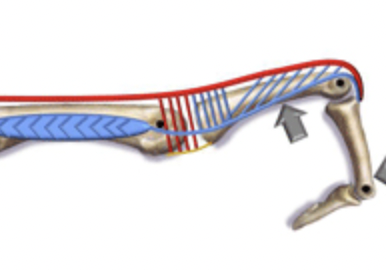Mechanism of Interneural Edema in Carpal and Cubital Tunnel
Filed under Diagnoses
Mechanism of Interneural Edema
Over the last few weeks I have been learning about ultrasonic imaging and carpal tunnel syndrome. When reviewing carpal tunnel syndrome, I learned that intraneural edema is a common sign of compression injuries such as carpal tunnel and cubital tunnel. There are numerous causes of carpal tunnel syndrome, and every scenario ends with the reduction of available space within the carpal tunnel and the inevitable compression on the median nerve (carpal tunnel edema). What I did not know was that chronic compression on the nerve can disrupt and open the blood nerve barrier around the perineurial layer. This allows for blood to flow freely into the nerve causing swelling or interneural edema. Since the nervous system lacks lymphatic drainage in the endoneural space, swelling inevitably increases pressure and disrupts the flow of blood to the nerve resulting in a metabolic conduction block (Cooper, 2014). One animal study found that an increase in pressure as little as 30 grams of force (about the weight of an average lightbulb) over the course of 1 hour was enough to disrupt the blood nerve barrier around the median nerve and cause diffusion (Kobayashi et al., 2005).
Normal Nerve No Diffusion

Nerve 30 Grams of Force with Diffusion

Nerve 90 Grams of Force Severe Diffusion

Chronic compression and decreased blood flow lead to impairment in nerve conduction. One source states that functional deficits are seen sequentially in the following order: motor, proprioception, touch, temperature, pain, and then sympathetic function (Cooper, 2014). Therapeutic activities such as nerve gliding exercises are hypothesized to increase nerve mobility and release the nerve from the sight of compression. Additionally, surgical decompression can help to alleviate symptoms, but the timeline for neural repair is largely based on the severity of nerve damage that has occurred. As neural edema subsides and blood flow to the nerve improves, the nerve begins to repair itself as long as the endoneurial tubes are intact. Patients are expected to regain sensation in the reverse order that they were initially lost (pain, temperature, proprioception).
Cooper, C. (20014). Fundamentals of hand therapy: Clinical reasoning and treatment guidelines for common diagnoses of the upper extremity [Second Edition]. Elsevier Mosby
Kobayashi, S., Meir, A., Baba, H., Uchida, K., and Hayakawa, K. (2005). Imaging of intraneural edema by using gadolinium-enhanced MR imaging: Experimental compression injury
1 Comments
Leave a Reply Cancel Reply
More To Read
INTEROSSEOUS MUSCLE TIGHTNESS TESTING
May 2012 No. 19 INTEROSSEOUS MUSCLE TIGHTNESS TESTING Judy Colditz, OT/L, CHT, FAOTA INTEROSSEOUS MUSCLE TIGHTNESS TESTING – ARE YOU DOING IT CORRECTLY? The common term “Intrinsic Tightness Testing” is a misnomer as it describes a maneuver specifically designed to test tightness of the interosseous muscles. The interosseous muscles are small, short-fibered muscles contained within…
Read MoreHand Therapy Interventions for Distal Upper Extremity Injuries and Conditions
Takata, S.C., Wade, E.T., & Roll, S.C. (2019). Hand therapy interventions, outcomes, and diagnoses evaluated over the last 10 years: A mapping review linking research to practice. Journal of Hand Therapy, 32(1), 1–9. Written by Brittany Carrie The Skinny Approximately 26.9% of orthopedic injuries and disorders of the upper extremity occur worldwide. Injuries are most…
Read MoreWays to Improve HEP Compliance in Hand Therapy
Ways to Improve HEP Compliance in Hand Therapy By: Dalton Busch One of the most important ways we see our patient’s progress is by assuring they are compliant with their prescribed home exercise program (HEP). Our patients are always encouraged to adhere to their prescribed program but compliance is easier said than done. Reminding patients…
Read MoreSign-up to Get Updates Straight to Your Inbox!
Sign up with us and we will send you regular blog posts on everything hand therapy, notices every time we upload new videos and tutorials, along with handout, protocols, and other useful information.






The inter neural edema is fascinating.